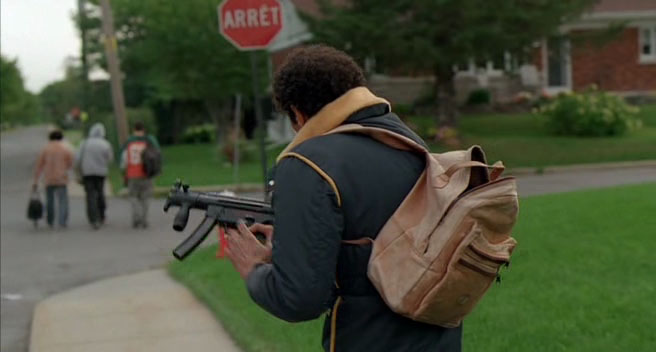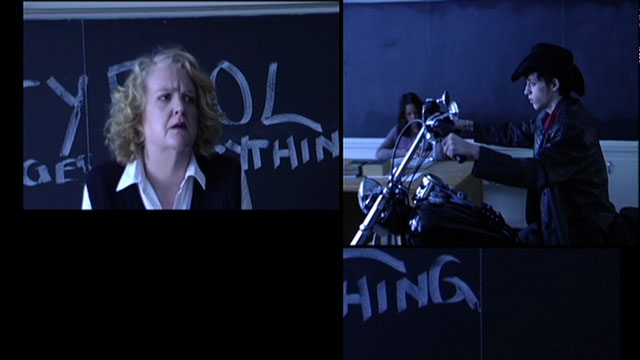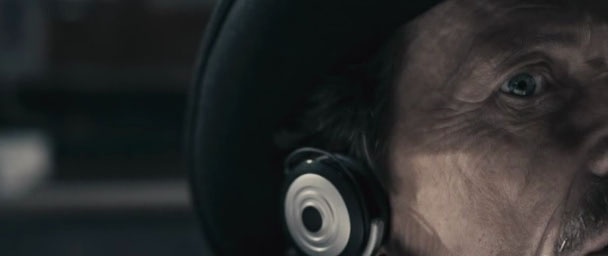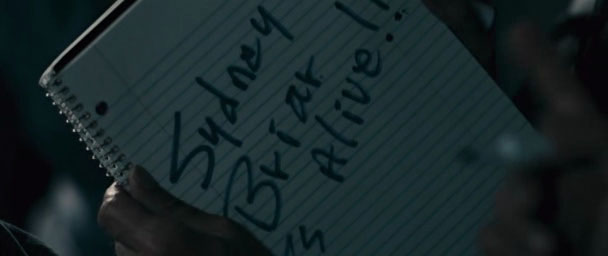49th Parallel (1941)
The Archers wouldn’t exist as a production company and Pressburger wouldn’t get a co-director credit until the following year’s One of Our Aircraft is Missing – he just contributed the story for this Powell-directed piece of WWII propaganda. Movie hammers home its points (nazis are bad; Canada is great) with a series of episodes, each of which further weakens the nazi force which is inexplicably (I was spacing out during the first ten minutes) invading Canada and making their way south to the USA.
The first, last and most effective attacks are made by our valiant troops, who kick off the fun by bombing the nazi sub which has just landed six advance soldiers to secure a trading post. Now these six guys (led by hardass Eric Portman, kindly given a role the next year as a loyal allied copilot as payback from P&P for being such an effective nazi) constitute the entire german force in Canada – if they can cause some damage and make it to neutral USA they’ll be hailed at home as heroes, so it’s of moral importance to stop them. Seems perverse to me that my flag-swingin’ nazi-hatin’ country was considered a legal safe haven for german troops in ’41.
There I am in Canada, right between Carberry and ASSMNBOINE:

First stop: the outpost. They hang out there for a while, steal some gear and shoot a whole pile of eskimos. Meanwhile, horror of horrors, who should be at the outpost but Lawrence Olivier playing a French-Canadian trapper just returned from a year expedition (so unaware that Canada’s at war). F-C Olivier joins Japanese Mickey Rooney from Breakfast at Tiffany’s and Blackface Bing Crosby from Holiday Inn in the Casting Mistakes Hall of Fame. If the movie was meant as a love letter to Canada, I can’t figure why Powell would want to start off with such a loud, ridiculous caricature of a Canadian. Maybe Olivier, recently in Rebecca, brought great publicity to the project so nobody wanted to risk insult by having him tone down the accent. Anyway, he quickly gets up to speed, decides what side he needs to be on, and makes a grab for the radio, getting himself killed. The nazis hail a plane, then kill the pilots and take off, getting one man shot by an eskimo.
What’s the only thing hammier than Laurence Olivier as a French Canadian? Laurence Olivier as a dying French Canadian. “Let me axe you one kestion.”

Plane crashes in the water – that’s another nazi down, four to go. They stumble into a group of religious commie idealists with german roots led by noble Anton Walbrook (ballet instructor in The Red Shoes), and thinking they’ve found kindred souls, Portman makes a big hitler speech which falls flat. Time to move on, but one nazi (Niall MacGinnis – not a very german sounding name – of The Edge of the World, later Zeus in Jason and the Argonauts) is inspired by the freedom of this community, decides to stay on and be a baker and be in love with hot local chick (Glynis Johns of The Sundowners, The Cabinet of Caligari), so other dudes execute him. Harsh segment, but also the most beautiful part of the film, visually and idealistically.
Germans always heil each other before going to bed:

Big city parade, the authorities are closing in on our men. They make an announcement describing the three germans – one cracks under pressure and gets captured. Last two nazis hide out in the woods, bust in on a society escapee, pacifist writer Leslie Howard in his teepee, enjoy his hospitality then tie him up and break all his stuff to settle a political disagreement. Our pacifist escapes, chases the guys down, and beats the shit out of one of ’em. I see Leslie Howard played Henry Higgins in Pygmalion – makes sense, he seems the Higgins type. He was killed in the war a couple years after this came out.
This was meant to be inspirational:

Last guy (Portman, natch) makes it to the border on a freight train, runs into an AWOL soldier (Raymond Massey of The Fountainhead, East of Eden) and takes his uniform. Soldier wakes up, realizes they’ve made it to the states, but convinces the train dudes to send ’em back over the border (still locked in their freight car) with the excuse that Eric Portman wasn’t on the manifest. Massey advances on Portman, giving one of the best final lines in cinema history: “I’m not asking for those pants… I’m just taking ’em.”
Edited by David Lean (which is why it’s over two hours long, ha) who’d start directing the following year, and shot by the future D.P. of Lean’s Lawrence of Arabia. Movie is too talky and obvious, but then, it’s a government-funded piece of propaganda. Given that fact, and the problems of filming during wartime, the movie is almost impossibly good – and at the very least it’s a nice tour through Canada.
–
I Know Where I’m Going! (1945)
Whew, a wonderful poem of a film, foggy and deadly romantic. Wendy Hiller (Eliza in that same Pygmalion with Leslie Howard, which now I must see; in Lynch’s The Elephant Man 35 years later) meets dashing Roger Livesey (the fat man in Colonel Blimp…!) on her way to meet her fiancee and falls in love with him instead.
Title is well explained in the elegant opening credits segment. Joan (Hiller) is obsessed with wealth and manages to climb higher and higher, finally gets engaged to super-wealthy guy who lives on a remote Scottish isle. One of my favorite-ever scene transitions, a puff of smoke from a top hat turns into the smokestack of a train engine, and she’s off to be married.

After a nuts dream sequence aboard the train (see above), Joan finds that she can’t cross to the island because of the fog, nor can anyone cross from there to pick her up. Stranded, she tries not to make friends with Torquil MacNeil (Livesey) but can’t seem to help it… hangs out on the mainland with him, his welcoming friend Catriona (Pamela Brown, Hoffmann’s silent companion), and local falconer Col. Barnstaple (an actual falconer, does a hilarious job in his only acting role).
Livesey and Pamela:

Barnstaple and Hiller:

Conflict arises because Joan is starting to like Livesey (an awfully likeable guy – friendly and handsome and a good dancer, plus it turns out, the laird of the island where her man lives). No longer knowing where she’s going (!), she panics, decides she must get to the island immediately. Praying for wind to lift the fog didn’t work, since now the wind is too high to sail, but she bribes the boatman’s son into taking her. That doesn’t work out, ship is almost wrecked, saved by brave Roger. The next day, she’s finally headed for the island, Roger staying behind. Roger strolls into an ancient castle to which his family has been forbidden entry for generations and, well, the ending is too wonderful to retell.

Adding to the spooky atmosphere is music by Allan Gray (protagonist of Vampyr). There’s more: falcons, a whirlpool, and a phone booth by a waterfall, plus glorious location photography, but I’ll be watching it all again soon.
Finally, since it’s awards season in the movie world, one of my three known readers David Cairns has awarded this site a Premio Dardos. David writes the only film blog I read, the tremendously entertaining Shadowplay, and he still finds time to contribute articles to The Auteurs. The Premio Dardos is a JPEG image of unknown origin (unless I bother to google it) that comes with a series of rules I might not follow, but it’s sorta like if your shitty local band gets paid a compliment by a nationally-touring rock act – still an honor.





























